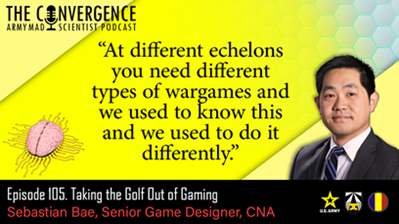“At different echelons you need different types of wargames and we used to know this and we used to do it differently”
[Editor’s Note: Army Mad Scientist continues our series of blog posts and podcasts in the run up to our Game On! Wargaming & The Operational Environment Conference, co-hosted with the Georgetown University Wargaming Society, on 6-7 November 2024 — additional information on this event and the link to our registration site may be found at the end of this post (below).
In today’s episode of The Convergence podcast, Army Mad Scientist interviewed Sebastian Bae, Senior Wargame Designer at CNA, adjunct assistant professor at Georgetown University teaching graduate wargame design, and designer of the phenomenally popular Littoral Commander: Indo-Pacific — the single most cited game in the host of responses we received from our Calling All Wargamers crowdsourcing exercise last spring. In this fascinating conversation, Mr. Bae explores how wargaming can help better prepare our Soldiers and Leaders for a complex Operational Environment — Read on!]
[If the podcast dashboard above is not rendering correctly for you, please click here to listen to the podcast.]
 Sebastian Bae is a Research Scientist and Senior Game Designer at CNA’s Gaming & Integration program — working in wargaming, emerging technologies, the future of warfare, and strategy and doctrine for the U.S. Navy and Marine Corps. He is the game designer for Littoral Commander: Indo-Pacific, a commercially available, professional military educational wargame exploring peer conflict and future technologies. Sebastian also serves as an adjunct assistant professor at the Center for Security Studies at Georgetown University, where he teaches a graduate course on designing educational wargames. He has taught similar courses at the U.S. Naval Academy and the U.S. Marine Corps Command & Staff College. He is also the faculty advisor to the Georgetown University Wargaming Society, the Co-Chair of the Military Operations Research Society Wargaming Community of Practice, and a former Non-Resident Fellow at the Brute Krulak Center for Innovation and Creativity. Previously, he served six years in the Marine Corps infantry, leaving as a Sergeant. He deployed to Iraq in 2009.
Sebastian Bae is a Research Scientist and Senior Game Designer at CNA’s Gaming & Integration program — working in wargaming, emerging technologies, the future of warfare, and strategy and doctrine for the U.S. Navy and Marine Corps. He is the game designer for Littoral Commander: Indo-Pacific, a commercially available, professional military educational wargame exploring peer conflict and future technologies. Sebastian also serves as an adjunct assistant professor at the Center for Security Studies at Georgetown University, where he teaches a graduate course on designing educational wargames. He has taught similar courses at the U.S. Naval Academy and the U.S. Marine Corps Command & Staff College. He is also the faculty advisor to the Georgetown University Wargaming Society, the Co-Chair of the Military Operations Research Society Wargaming Community of Practice, and a former Non-Resident Fellow at the Brute Krulak Center for Innovation and Creativity. Previously, he served six years in the Marine Corps infantry, leaving as a Sergeant. He deployed to Iraq in 2009.
Army Mad Scientist sat down with Sebastian Bae to discuss his views on wargaming in the military, his thoughts on the various technology evolutions, and how the Department of Defense can better harness this unique tool. The following bullet points highlight key takeaways from our conversation:
-
-
-
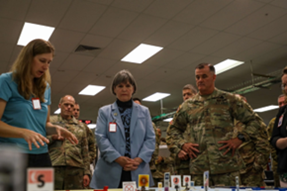
Leaders attend the senior leader forum as part of Pacific Joint Allied Sustainment System (JASS) strategic-level discussion within UNIFIED PACIFIC 23. / Source: DVIDS, (U.S. Army photo by Russell Dodson) “Wargaming is sort of like golf – it is often the refuge of the “wealthy” — the senior leaders — and it does not get lots of play at different echelons typically.” Wargaming capabilities are rarely pushed down to the lowest echelons and tactical level. They tend to be concentrated at the Combatant Command-level, creating a unique challenge as the games often only serve a specific viewpoint on any given problem.
-
-
-
-
-
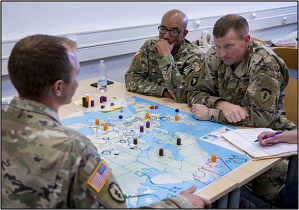
Students practice strategy during hands-on exercises at the Basic Analytic Wargaming Course taught by the Naval Postgraduate School Wargaming Mobile Education Team in Wiesbaden, Germany, Aug. 30 – Sept. 10, 2021. / Source: Army Integrating different types of wargames throughout different echelons allows Soldiers to practice decision making at all levels of their careers. This is critical because a Soldier’s decision space and perspective changes as they move from echelon to echelon. Ideally, the games should evolve as the Soldier moves up through their career path to represent the changes in their decision-making requirements.
-
-
-
-
-
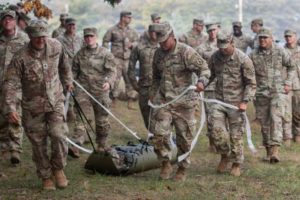
Soldiers with the 10th Mountain Division learn how to properly drag a casualty in a Skedco during Alpine Readiness Week on Oct. 2, 2023, on Fort Drum, New York. / Source: Army (U.S. Army photo by Spc. Salvador Castro) Establishing a wargaming ecosystem consisting of both microgames and larger wargames creates an opportunity to explore topics outside of the typical kinetic, combat-centric wargames, such as Medical Services and CASEVAC, water distribution, and maintenance, that may be better suited for smaller games that can be played in 20-minutes. Additionally, a wargaming ecosystem with microgames provides additional opportunities to expose younger Soldiers to wargaming. Increasing wargaming literacy across the force enhances the quality of larger, kinetic games as the player pool improves.
-
-
-
-
-
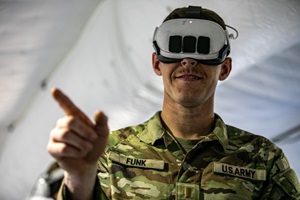
2LT Kyle Funk, a platoon leader assigned to the 323rd MP Company, uses a virtual-reality headset for training during Exercise Northern Strike at Oscoda-Wurtsmith Airport. / Source: Army (U.S. Army photo by Staff Sgt. Thomas Moeger) Certain aspects of wargaming can benefit from advanced technology now available. However, integrating new technology into government or military wargaming comes with inherent limitations. Innovation with technology is difficult due to security risks, network incompatibility, and trademark, copywrite, and intellectual property constraints.
-
-
-
-
- Collaboration between the professional and commercial sectors of gaming is possible with effective processes and exploration, specifically in publishing and education. The military can utilize commercial game publishers to produce games on a larger scale that can be proliferated throughout the force at different echelons.
-
-
-
-
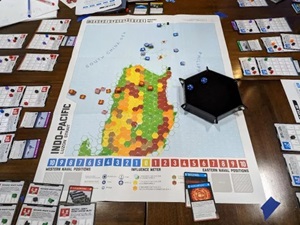
Littoral Commander: Indo-Pacific / Source: BoardGameGeek (Photo by Sebastian Bae) Sebastian Bae’s educational wargame, Littoral Commander – Indo Pacific, began as a project during the COVID pandemic to inform the broader force about future force design and multi-domain concepts at scale. Over time, the game has become a critical part of education across the Joint force and partner nations. Originally designed for the Marine Corps, the Air Force uses Littoral Commander to teach their six-step dynamic targeting process — find, fix, track, target, engage, and assess or F2T2EA — while a German Officer training at the Marine Corp’s Expeditionary Warfare School has adapted the game to create a German version now utilized throughout the German Army.
-
-

Stay tuned to the Mad Scientist Laboratory for our next episode of The Convergence podcast on 17 October 2024, when we explore how NATO is employing wargaming to integrate and build staff proficiency across the Alliance’s 32-member nations’ militaries.
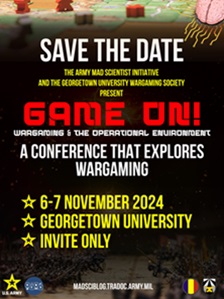
We hope this post has piqued your interest regarding how wargaming can inform us about the Operational Environment and support Professional Military Education. Army Mad Scientist and the Georgetown University Wargaming Society want to invite you to learn more about this topic at our Game On! Wargaming & The Operational Environment Conference.
What: An in-person conference to explore Wargaming and how it can help the Army better understand the Operational Environment
When: 6-7 November 2024
Where: The Healey Family Student Center, Georgetown University, 3700 Tondorf Road, Washington, DC 20057
Why: To explore new wargaming methods, new ways to incorporate learning into Professional Military Education, and have an open dialogue with wargamers inside and outside the military.
***In order to attend, you must register through Eventbrite — click here now to reserve your seat — access will be limited to registered attendees only!***
Stay tuned to the Mad Scientist Laboratory for conference updates and forward any questions you may have to madscitradoc@gmail.com
In the meantime, check out the following Mad Scientist Laboratory wargaming related content:
“Best of” Calling All Wargamers Insights (Part 1)
Civilian Harm Mitigation and Response (CHMR) Considerations in Wargaming LSCO, Achieving Victory & Ensuring Civilian Safety in Conflict Zones, and associated podcast with Andrew Olson
Brian Train on Wargaming Irregular and Urban Combat
Live from D.C., it’s Fight Night (Parts One and Two) and associated podcasts (Parts One and Two)
Would You Like to Play a Game? Wargaming as a Learning Experience and Key Assumptions Check and “No Option is Excluded” — Using Wargaming to Envision a Chinese Assault on Taiwan, by Ian Sullivan
Using Wargames to Reconceptualize Military Power, by proclaimed Mad Scientist Caroline Duckworth
Gaming the System: How Wargames Shape our Future and associated podcast, with guest panelists Ian Sullivan, Mitchell Land, LTC Peter Soendergaard, Jennifer McArdle, Becca Wasser, Dr. Stacie Pettyjohn, Sebastian Bae, Dan Mahoney, and Jeff Hodges
The Storm After the Flood virtual wargame scenario, video, notes, and Lessons Learned presentation and video, presented by proclaimed Mad Scientists Dr. Gary Ackerman and Doug Clifford, The Center for Advanced Red Teaming, University at Albany, SUNY
Gamers Building the Future Force and associated podcast
Disclaimer: The views expressed in this blog post do not necessarily reflect those of the U.S. Department of Defense, Department of the Army, Army Futures Command (AFC), or Training and Doctrine Command (TRADOC).

